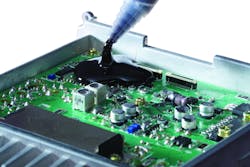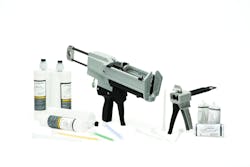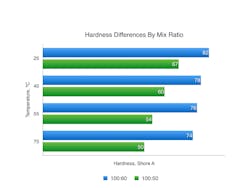Dual-Barrel Dispensers Put an End to Improperly Mixed Adhesives
Mixing two-part adhesives properly is crucial for good bonds, and easy to do with cartridge dispensers.
Anyone who has worked with two-component adhesives in production environments knows it can be tricky to get the mix ratio right. In fact, our studies show that mixing errors are the leading cause of manufacturing inefficiencies and scrap in both bonding and potting operations.
Many two-component adhesives must first be mixed as precise proportions of hardener and resin. Even small deviations from the ideal mix ratio can prevent adhesives from curing properly. And poorly mixed adhesives may not cure to their full hardness or they may not cure at all.
Bad mixes can also trigger highly exothermic reactions, ones that give off heat that damages nearby components or cause out-of-control shrinkage. These reactions can be especially costly if they ruin circuit boards with expensive components already installed, which is a distinct possibility because potting compounds are typically applied last.
The worst mixing errors are the ones that aren’t noticed right away. Incorrectly mixed adhesives can make joints or encapsulations that look good, but actually have diminished mechanical properties.
One of the most effective ways to avoid mix-ratio problems is to use a dual-barrel dispensing gun that works with cartridges containing the proper ratio of adhesive components. These dispensers provide consistent, volumetrically precise control of adhesive components and make mixing and applying two-component adhesives less messy on the shop floor. And unlike automated dispensers, dual-barrel guns require no investment in capital equipment.
In the right applications, dual-barrel dispensers have some compelling advantages. For example, manufacturing becomes more efficient because dual-barrel cartridge dispensing is fast and in part because it prevents rework and scrap. However, not every adhesive and application are well-suited to dual-barrel cartridge dispensers. With that in mind, here’s an overview of what makes a good fit:
The right type of adhesive. Dual-barrel dispensers can accommodate a broad range of adhesives, but some simply don’t lend themselves to this dispensing method. Highly filled products, such as thermally conductive potting compounds, don’t work well in dual-barrel dispensers. Adhesives with extreme viscosities also don’t dispense well in them. And finally, these dispensers only work with adhesives that have fixed-mix ratios. Even with these limitations, adhesive manufacturers supply over 50 dual-barrel cartridge-friendly formulations.
The right production volume. Other automated dispensers are much more efficient than dual-barrel cartridge dispensers for high-volume production processes. For example, dual-barrel dispensers are not likely to be the best options for continuous sealing applications that require a bead of adhesive applied over a long distance—such as automotive window sealing. But even with high-volume applications, dual-barrel devices can help scale up to full production volumes. Prototypes and first-article production may start out in dual-barrel cartridge dispensers even if ongoing production uses another sort of automated dispenser. (Consistency between dual-barrel cartridge systems and bulk formulations makes it possible to scale up without changing adhesives.)
The right workflow. Dual-barrel dispensers are particularly useful in assembly lines that intermittently apply adhesives. Many job shops fall into this category, as do many lean, just-in-time and continuous-flow assembly lines. In these cases, buying adhesives in bulk may not make sense.
Mixing Up the Mix Ratios
For two-component adhesives that need to be manually mixed, mix ratios can be given by weight or volume. The ratios are usually expressed in terms of parts per hundred (PHR), with the proper amounts of each component calculated by the following formulas:
PHR/100 x Weight of Resin = Weight of Hardener
PHR/100 x Volume of Resin = Volume of Hardener
To get the right mix, users must use the correct PHR spec and calculate the appropriate measurements of the resin and hardener. The ingredients are then weighed on a scale or measured in a graduated cylinder. Sounds simple enough, but these measurements can be fraught with errors. Mistakes in PHR calculations and measurements happen all the time.
One of the most common errors involves confusing the by-weight and by-volume mix ratios, which will differ for given adhesives. If you confuse the two ratios, which is a common mistake, the adhesive’s properties will suffer. To illustrate this point, we mixed two batches of our 20-2180, a popular polyurethane potting and encapsulating material. Batch One has the correct 100:60 ratio by weight. Batch Two had a 100:50 ratio by weight—which is the correct by-volume ratio. This seemingly small error keeps the adhesive from developing its full hardness at room and elevated temperatures. The drop-off in hardness as temperature increased is also more pronounced with the incorrectly mixed batch.
Dual-Barrel Dispensing Tips |
|
Dual-barrel cartridge dispensers are extremely easy to use, which is the whole point. But they are not completely foolproof. In fact, some of the same curing and application problems that plague traditionally mixed two-component adhesives also affect cartridge-based adhesives if careful attention isn’t paid to setting up the dispensing gun. Fortunately, all it takes to avoid any dispensing problems is following a few simple steps: Use the best mixer. Dispensing guns are outfitted with one of several interchangeable static mixers, and each adhesive carries a recommendation for a specific mixer. It’s important to follow that recommendation because individual mixers have to be matched to each adhesive’s viscosity characteristics. Attach the mixer. Different-size cartridges have different attachment methods. On 50- and 75-ml models, luer-style mixers attach to the cartridge with a twist. On 200- and 400-ml models, a locking nut slips over the mixer and secures it to the cartridge. Get the ratio right. Dispensing guns support a few different mix ratios—typically, 1:1, 2:1, 4:1, and 10:1. So make sure the mix-ratio setting on the gun is correct. Orient the cartridges. Cartridges for 2:1, 4:1, and 10:1 adhesives have one correct orientation relative to the plungers on the gun. Inspect the cartridge. It’s a good idea to check the cartridge pistons to verify they are at an even height. Also, there should not be any visible evidence of air pockets along the cartridge walls. Fire a blank. The first shot of material often does not mix well, especially with lower viscosity adhesives. So always dispense and discard a small amount of adhesive when starting a new cartridge. Dispense properly. Different adhesives have different recommendations for dispensing style—such as dots or beads. For consistent dispensing, hold the cartridge horizontally with a slight downward angle. Mind the clock. Fast-curing epoxies can begin gelling in the static mixer after just a few minutes. If there are long pauses between applications, the mixer should be removed and replaced. And finally… Don’t forget to remove the cap from the cartridge. |




